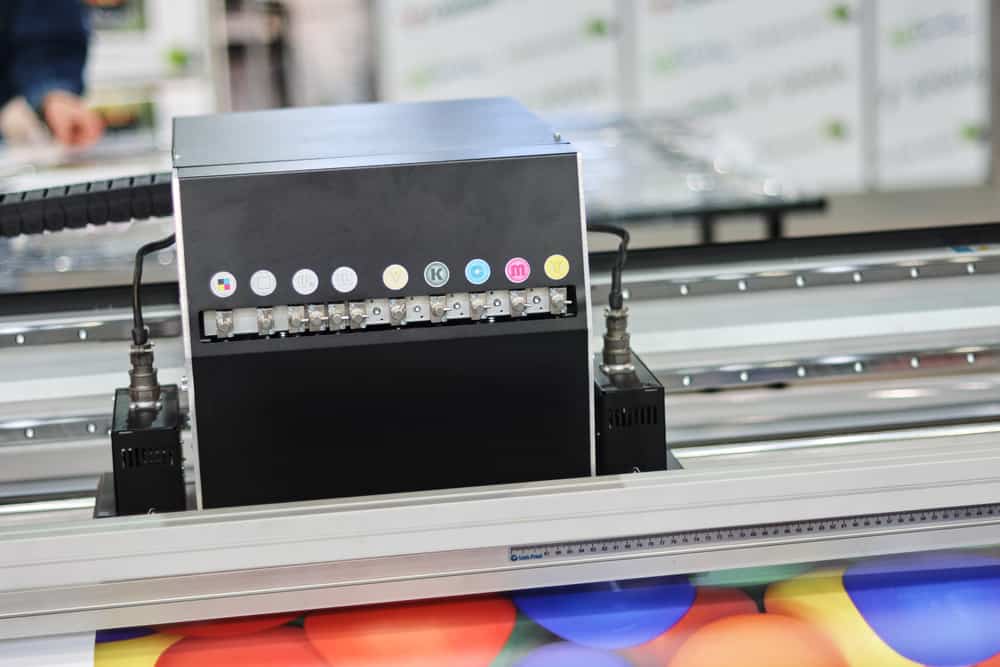This post may contain affiliate links, which means that we get commissions for purchases made through such links, at no additional cost to you. As an Amazon Associate we earn from qualifying purchases.
As interest grows in waterproof labels, it’s essential to ask if thermal inkjet is waterproof. Our team has studied wide on different label printers, and this article contains our findings, specifically on thermal inkjet prints. Let us walk you through the qualities of thermal inkjet prints, whether they are waterproof or not.
Is thermal inkjet waterproof? All inkjet printers, including thermal inkjets, make use of water-based inks. As such, they are not waterproof. Thermal inkjet prints will smudge or ruin if the label ever gets wet. The simplest way of making thermal inkjet prints waterproof is to add a waterproof coating to the image. What’s more, it is better to use synthetic media if you want a waterproof print.
Many thermal inkjet labels claim to be waterproof, but the only real waterproof thermal inkjet labels have either laminate or varnish coating. As you read on, we will explain what you can do to make you thermal inkjet prints waterproof.
Please do not confuse thermal inkjet printing with thermal printing. If you are looking for information on waterproof thermal prints, please click here.

How to Waterproof Thermal Inkjet Labels?
The only way to make a thermal inkjet label waterproof is to laminate it or add a varnish coating. These would help secure both the label surface and the print, sealing them off from water damage, as well as damage from other elements. In both cases, you will print your labels first before making it waterproof.
What is a varnish coating? What is a laminate coating? How do they make thermal inkjet prints waterproof? Please read on, as we explain.
Varnish Coating
Varnishes are liquid coatings that you can add to your labels after printing. What sets varnish apart is that you can choose to apply varnish coating on a specific spot rather than on the entire label. They are available in either of two finishes – matte or gloss. The right finish to use is one that matches the paper type. If you have matte papers, use matte varnish; and if you have glossy paper, use glossy varnish.
Varnishes are typically cheaper than laminates. They are, however, not as durable and long-lasting as laminates. But still, they offer protection against abrasions, scuffs, and water damage. You can use varnishes on both paper and synthetic materials. To learn about the different types of varnish coating, click here.
Laminate Coating
Laminates offer the best form of label protection, but different laminate types offer different protection grades. They generally provide better texture and sheen than varnishes. They also come in either matte or gloss finishes.
Gloss laminates will make your labels shiny with a polished look. Conversely, matte laminates will make your label surfaces smooth with a no-glare finish. Both options are suitable for labels prone to moisture and exposure to liquids. They also protect the labels from UV light, abrasion, chemicals, and tough environments.
To learn about the different types of laminate coating available, click here
✅ Video – Laminate and Varnish cover finishes – Warners Midlands Plc
Andy York explains how laminate differs from varnish covers in this video. He shows magazines, catalogues, and brochures to demonstrate these differences. What better way is there to know what suits your needs apart from evaluating the outcomes? Watch this video and see for yourself how the outcomes of laminate coating differ from those of varnish coating.
Why is Synthetic Media Better For Waterproof Prints?
Synthetic materials, such as vinyl and polypropylene, are more water-resistant than paper rolls. As such, they offer better protection against water-damage. If your label application requires waterproof qualities, you should use synthetic media.
While laminate or varnish coating will make your label waterproof, the type of media you use also matters. If you varnish or laminate paper labels, the print will be waterproof, but the paper material might still be susceptible to water damage. This means that water will not ruin the ink, but it can cause the paper to washboard and begin to decay.
Conversely, synthetic media are waterproof already, so there will be no problem with water exposure. Adding laminate or varnish to such labels will further protect the imprints. The combination of synthetic media with laminate or varnish is the best for waterproof printing with thermal inkjet printers.
The Different Types of Varnish Coating?
Aqueous varnish and ultraviolet varnish are the two most common types of varnish coatings. However, there are other specialty vanishes. All varnish types are effective for protecting labels from smudging and abrasion.
The different types of varnish coating are as follows:
Aqueous Varnish
Aqueous (or water-based) varnish is commonly used to coat labels and protect them from scuffing, abrasion, and water. Aqueous varnishes also help resists yellowing, a common problem with aging unprotected labels.
The different ways to apply aqueous varnish include spraying, writing (spot application with a pencil), and overprinting with a printer. They are not only effective but also sustainable and nontoxic. You can recycle treated paper without giving off harmful byproducts.
Ultraviolet (UV) Varnish
UV Varnishes offer better protection from water than aqueous varnishes. After applying UV varnish, you’ll have to expose it to UV light for polymerization. This hardens the coating and secures your label and improves its visual qualities. UV varnishes are also available in both matte and gloss finishes. Other specialty finishes include tints and glitters, among others.
More so, UV varnishes improve the appearance of deep colors, such as rich blacks and blues. So they are perfect for image-rich projects. You can also apply them to specific spots or on the entire label. It’s best to use UV coatings alongside UV inks.
Specialty Varnishes
Several varieties of specialty varnishes exist, which can help enhance and protect your labels. One such specialty varnish is the soft-touch varnish, an aqueous coating that is pleasant to the touch and has an ultra-matte look. Specialty varnishes offer protection from the elements, as well as visually stunning appearances.
The Different Types of Laminate Coating
Laminate coatings are of different types, including polypropylene and polyester laminates. These are made from different film materials. Aside from these, there are specialty laminates like holographic films and metalized films. These coatings offer waterproof and tear-proof protection to labels.
The different types of laminate coating are as follows:
Polypropylene Laminates
These are the cheapest and most popular laminates on the market. They are not only cheap but also durable and effective. You can get them in gloss, matte, or satin finishes. They are suitable for applications that could scratch because they are softer. Another advantage is that you can write on them with dry-erase markers, among other types.
Polyester Laminates
Polyester laminates are expensive but they are also more durable than other types. They offer great strength and resistance to abrasion. Their hard coatings are also resistant to tearing and scuffing, in satin, gloss, or matte finishes. Aside from being waterproof, polyester laminates also offer heat resistance.
Specialty Laminates
While polypropylene and polyester laminates are clear films, there are other varieties of specialty laminates whose films aren’t clear. Metalized films, for instance, come in silver and gold colors. There are also holographic films, as well as iridescent films. Iridescent films are translucent and have the unique ability to shift colors.
Related Questions
How do thermal inkjet printers work?
Thermal inkjets use thermal technology to apply ink to print media. They are also called bubble jet printers because when the printer heats the ink, air bubbles force out the ink and make them stick to the paper.
Thermal inkjets are cheap, fast, and work well with various surfaces and media types. You can use them on both paper and synthetic media.
Is thermal inkjet the same as thermal printers?
Thermal inkjets are different from thermal printers. Thermal printers use heat instead of ink to print barcodes and receipts on special heat-sensitive papers. Thermal inkjets, on the hand, have ink cartridges with a built-in resistor that creates air bubbles when heated. The bubbles, in turn, cause the ink to drop on the print medium.
Thermal inkjets are a type of inkjet printer. But they are not the same as commercial inkjets. Thermal inkjets are slower and are more commonly used in home and consumer household settings. They are also cheaper.
Is thermal printing waterproof?
Direct thermal prints are generally not waterproof. But there are water-resistant labels. They can resist damage from brief contact with water but they will not hold up if you submerge them in water. The same applies to thermal transfer prints but they are much more durable and water-resistant than direct thermal labels.
Thermal transfer labels are more resistant to scratch, chemicals, and water. They are suitable for outdoor applications and water-prone product labels. Just like thermal inkjet labels, you can make thermal labels waterproof by adding a layer of laminate or varnish coating to them.
We have a more detailed article that answers this question – Is thermal printing waterproof? Click here to read our comprehensive answer.
Conclusion
Laminate and varnish coatings help protect labels from water, dirt, scratching, smudges, and fingerprints. They also offer scuff resistance and improve the appearance of labels. If you match the coating with the appropriate material, your print will be more secure and appealing. You can add them to your thermal inkjet prints to make them waterproof.
